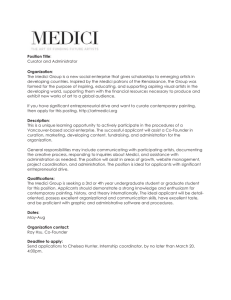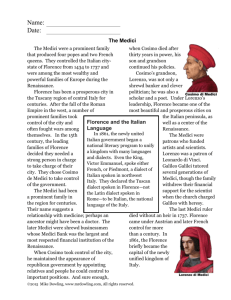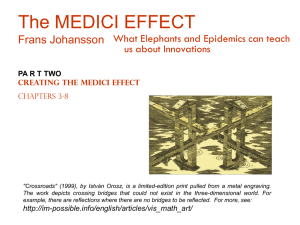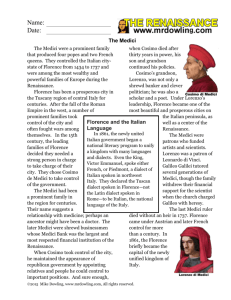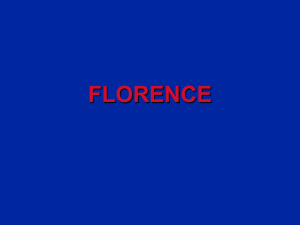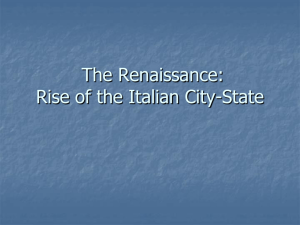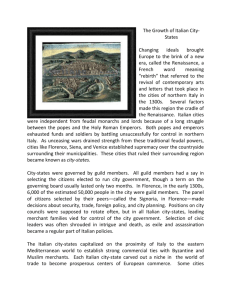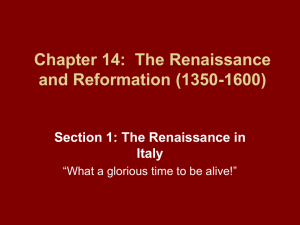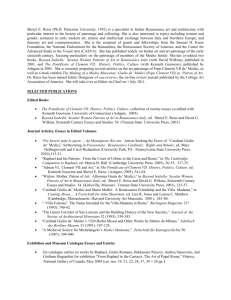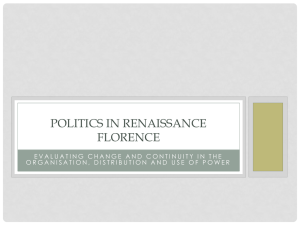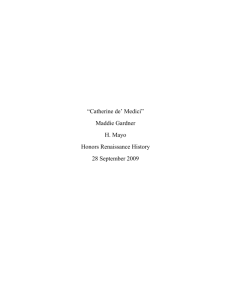Chapters 1-2
advertisement
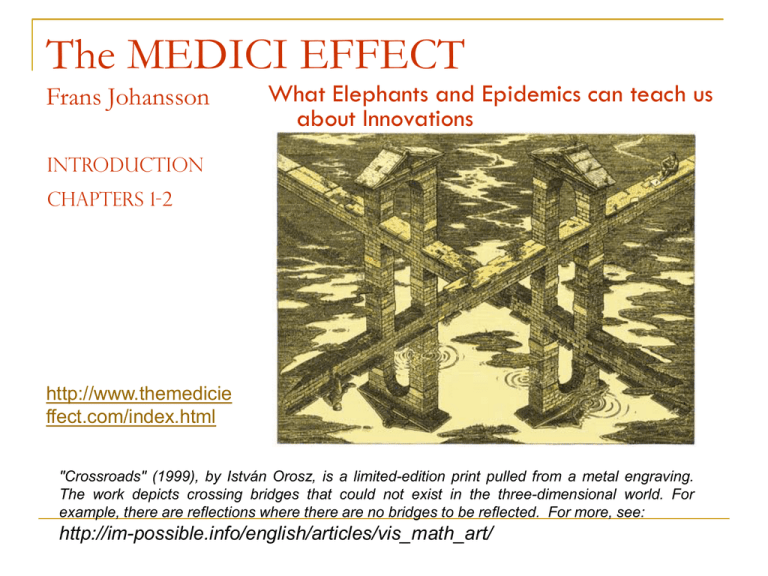
The MEDICI EFFECT Frans Johansson What Elephants and Epidemics can teach us about Innovations Introduction Chapters 1-2 http://www.themedicie ffect.com/index.html "Crossroads" (1999), by István Orosz, is a limited-edition print pulled from a metal engraving. The work depicts crossing bridges that could not exist in the three-dimensional world. For example, there are reflections where there are no bridges to be reflected. For more, see: http://im-possible.info/english/articles/vis_math_art/ What is the Medici Effect ? •Groundbreaking innovations can best be created in the Intersections where cultures, domains and disciplines stream together. •This kind of remarkable innovations are called the Medici Effect. AND . . . The implications are ….. When society is at a crossroads The Medici Family The family was powerful and influential from the 13th to 17th century. Estimates suggest that the Medici family was for a period of time the wealthiest family in Europe. The Medici Bank was one of the most prosperous and most respected in Europe. The family acquired political power initially in Florence, and later in wider Italy and Europe. The family produced three popes (Leo X, Clement VII, and Leo XI), and Lorenzo il Magnifico, Ruler of Florence, patron of some of the most famous works of renaissance art. The Medici Family The accounting profession’s general ledger system was improved through the development of the double-entry bookkeeping system for tracking credits and debits. This system was first used by accountants working for the Medici family in Florence. Significant accomplishments of the Medici were: Agnolo di Cosimo 1(503-72) Cosimo I de' Medici undated; Oil on wood; Uffizi The sponsorship of art and architecture, early and High Renaissance art and architecture. Their money was significant because artists generally only made their works when they received commissions and advance payments. The first patron of the arts in the family, ordered the reconstruction of the Church of San Lorenzo. Cosimo I the Great erected the Uffizi Gallery in 1560 and founded the Academy of Design in 1562. Put on your Thinking Cap What is the Difference between the 13th Century and 2008 ? The Difference between the 13th Century and 2008 We didn’t believe that life was fair We didn’t believe that all people should be successful We didn’t believe that everything and everyone should be equal The king and queen may have been benevolent, but they certainly didn’t treat everyone the same Risk was rewarded And greatness was frequently achieved The Medici Effect “When you step into an intersection of fields, disciplines, or cultures, you can combine existing concepts into a large number of extraordinary ideas.” “We have met teams and individuals who have searched for, and found, intersections between disciplines, cultures, concepts, and domains. Once there, they have the opportunity to innovate as never before, creating the Medici Effect.” Frans Johansson, The Medici Effect, Harvard Business School Press, 2006, page 186. Doesn’t it sound like . . . . Morphologically Forced Choices? All new ideas are combinations of existing ideas Biomimetic Building Uses Termite Mound As Model The Eastgate Centre is a shopping centre and office block in central Harare, Zimbabwe. The building was designed to be ventilated and cooled entirely by natural means. Check out: http://www.treehugger.com/files/2006/08/biomimetic_buil_1.php http://www.inhabitat.com/2007/12/10/building-modelled-on-termites-eastgatecentre-in-zimbabwe/ George Soros He was born in Budapest in 1930. Survived the Nazi occupation and then fled communist Hungary for England, where he graduated from the London School of Economics. Came to the U.S. in 1956, at age 26. Accumulated a large fortune through the investment advisory firm he founded and managed. Chairman of Soros Fund Management, LLC Founded organization network dedicated to promoting the values of democracy and an open society. His foundation network spends about $400 million annually founder of The Open Society Institute. http://www.georgesoros.com/ http://www.soros.org/about/bios/a_soros Chapter 1: The Intersection—Your Best Chance to Innovate Monkeys and Mind Readers a tiny array of electrodes that, when attached to a monkey’s brain, recorded, interpreted and reconstructed activity in the motor cortex, the area of the brain that controls hand movement At first, the animals used their hands to play a simple game. Researchers turned off the hand control - Monkeys could still move the cursor. Computer science, biology, medicine, psychology, physics, mathematics Creative Ideas are . . . . New to the user Valuable Realized – social evaluation The Intersection Where fields meet Field = culture, domain, discipline Fields consist of concepts (knowledge, practices) Ideas make you do a double take Intersectional ideas compete for attention. Intersectional ideas compete for attention. They are surprising and fascinating. They take leaps in new directions. They open up entirely new fields. They occupy a space for a person, team, or company to call its own. They generate followers/ creators can become leaders. They provide a source of directional innovation for years to come. They can affect the world in unprecedented ways. Chapter 2: The Rise of Intersections— The Sounds of Shakira and the Emotions of Shrek 3 Distinct Force Behind Intersectional Innovation 1. 2. 3. The Movement of People The Convergence of Science The Leap in Computation
